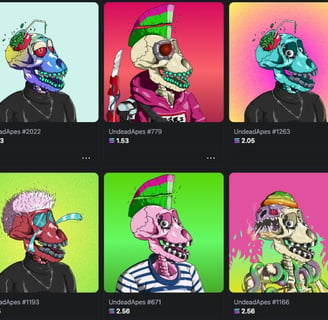Federal Jury Convicts NFT Co-Creator of Wire Fraud and Money Laundering
ARTE
11/6/20244 min read


Background on UndeadApes and Undead Lady Apes NFT Collections
The UndeadApes and Undead Lady Apes NFT collections emerged as distinctive digital assets within the burgeoning market of non-fungible tokens (NFTs). Launched by Berman Jerry Nowlin Jr. and Devin Alan Rhoden, these collections encapsulated a blend of artistic expression and innovative technology, setting a unique precedent for NFT projects. At the core of these digital collectibles lies the concept of digital ownership, where each token represents exclusive rights to a specific piece of artwork, verified on the blockchain.
The UndeadApes collection features a series of ape-themed artworks, characterized by a blend of vibrant colors and dystopian themes. This collection quickly captured the attention of NFT enthusiasts, as it appealed to both collectors and investors seeking unique tokens. The Undead Lady Apes, a complementary series, focused on female avatars that presented a similar aesthetic but with unique attributes designed to attract a different demographic within the NFT community. Together, these collections symbolize the merging of art and technology, offering a glimpse into the evolving landscape of digital ownership.
The Legal Proceedings Against Nowlin and Rhoden
The legal proceedings against Berman Jerry Nowlin Jr. and Devin Alan Rhoden began following allegations of conspiracy to commit wire fraud and money laundering related to their involvement in Non-Fungible Tokens (NFTs). These proceedings highlight the intersection of digital assets and traditional legal frameworks, indicating the rising scrutiny financial authorities are applying to the NFT market. The initial charges were laid in mid-2022, where investigators discovered irregularities in transactions connected to the sale of certain NFTs.
The prosecution argued that Nowlin and Rhoden engaged in a deceptive scheme to defraud investors during the NFT transactions, misrepresenting the value and authenticity of the digital assets. Over several court hearings, evidence was presented, including digital communications and transaction records that suggested a systematic effort to mislead buyers about the supposed worth and ownership of these NFTs. The defense countered by asserting that the NFT market is inherently volatile and that price fluctuations are a typical occurrence in this emerging sector. However, the court found the evidence compelling enough to proceed with a trial.
In early September 2023, a jury reached a verdict following a week-long deliberation. Both Nowlin and Rhoden were found guilty on multiple counts related to wire fraud and money laundering. This verdict sets a significant legal precedent, underscoring the potential for legal repercussions within the NFT space for similar deceptive financial practices. The implications of this conviction extend beyond just these individuals; they serve as a cautionary narrative for other creators and investors engaging in the NFT marketplace. As legal standards evolve, the accountability for fraudulent activities in this rapidly changing environment is likely to become more stringent in the future.
Sentencing and Potential Consequences
The recent convictions of NFT co-creators Nowlin and Rhoden for wire fraud and money laundering carry significant legal implications. Under federal law, both individuals face a maximum sentence that could include several years in prison. The specific penalties will ultimately be determined during the sentencing phase, where a federal judge will evaluate numerous factors. These factors can include the severity of the crimes, the defendants' prior criminal history, and the impact of the fraudulent activities on victims and the broader market.
In cases such as this, the judge may also weigh any mitigating circumstances, including the defendants' acceptance of responsibility and cooperation with authorities. Such considerations could lead to a more lenient sentence than what the maximum penalties would suggest. However, the gravity of financial crimes, particularly those involving new technologies like NFTs, often results in harsher sentencing due to their perceived threat to both consumers and the financial system.
Furthermore, beyond the immediate ramifications of prison time, the convictions could have extensive long-term repercussions for Nowlin and Rhoden. Their professional reputations may be irreparably damaged, limiting future career opportunities within the rapidly evolving tech and finance sectors. Additionally, civil lawsuits may arise from the fraudulent activities, potentially resulting in hefty financial penalties or restitution orders that could significantly impact their financial stability.
As the cases progress through the legal system, future developments may include appeals or negotiations for lesser charges. These possibilities could change the trajectory of the convictions, leading to different outcomes for Nowlin and Rhoden. The evolving landscape of digital currencies and established regulations around cryptocurrencies will also play a role in shaping the repercussions of these convictions.
The Broader Impact on the NFT Market and Regulation
The recent conviction of an NFT co-creator for wire fraud and money laundering has significant implications for the broader NFT market. As digital assets continue to gain traction, this case underscores the necessity for legal compliance within this fast-evolving sector. Regulatory bodies are currently scrutinizing the practices and operations of NFT creators and investors, raising essential questions about transparency and accountability in the marketplace.
As the NFT market expands, the precedent set by this conviction is likely to influence future regulatory actions. It signals to NFT creators that engaging in questionable or illegal practices can lead to serious consequences. In response, regulators may tighten existing frameworks or establish new guidelines to ensure that NFTs adhere to legal standards akin to those applicable to traditional securities. For investors and creators alike, understanding and navigating these regulations will be crucial. They must prioritize transparency and incorporate legal advisory practices into their operations to mitigate risks.
Furthermore, the implications extend beyond legal ramifications to the overall perception of NFTs as a legitimate asset class. Increased scrutiny can lead to heightened investor wariness, potentially stifling market growth. Creators and investors should remain vigilant about legal compliance and operational integrity to maintain confidence within the market. Best practices such as conducting thorough due diligence, keeping abreast of regulatory developments, and seeking counsel from legal experts specializing in digital assets will be vital strategies in avoiding legal pitfalls.
In conclusion, the impact of this conviction on the NFT landscape is multifaceted. It serves as a wake-up call for creators and investors, emphasizing the importance of adhering to legal and regulatory standards while navigating the complexities of the NFT market. The future of this digital asset class may hinge on the ability to establish a robust legal framework that fosters both innovation and security.
